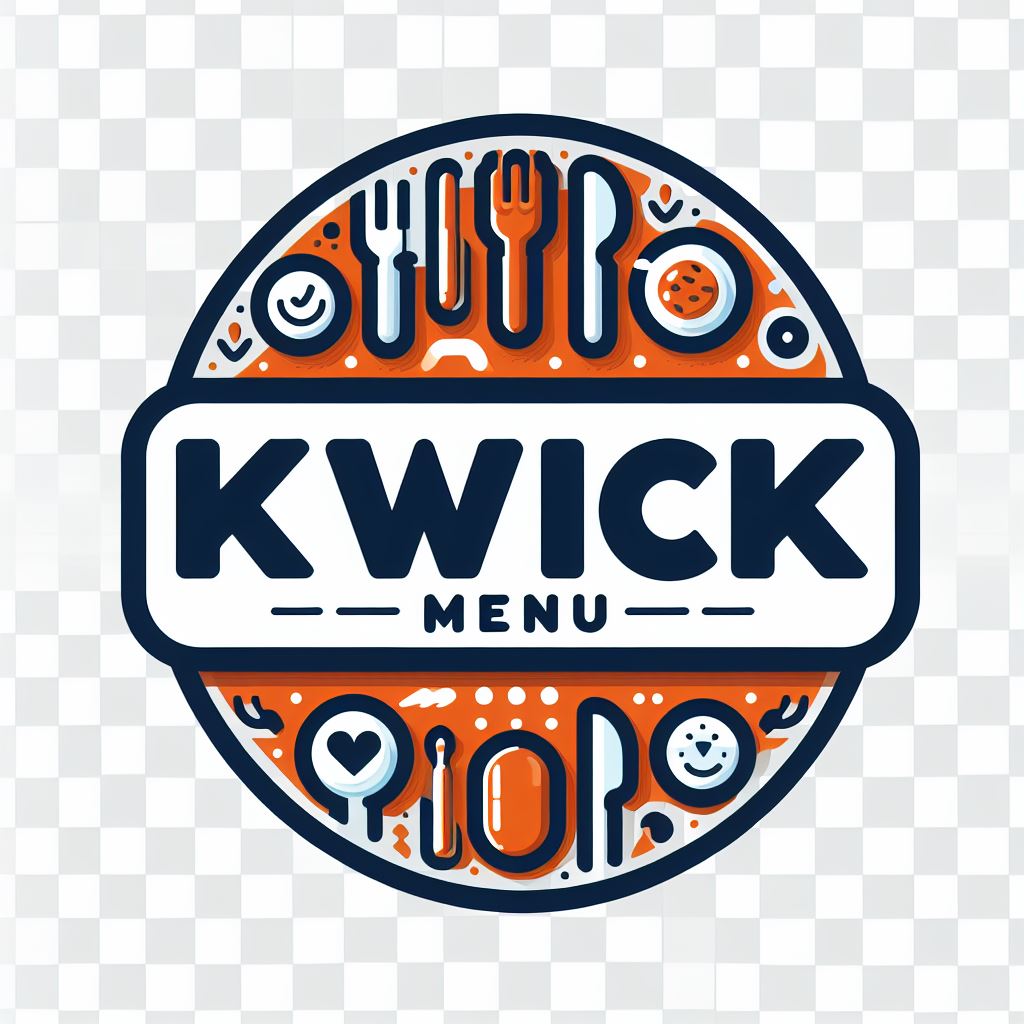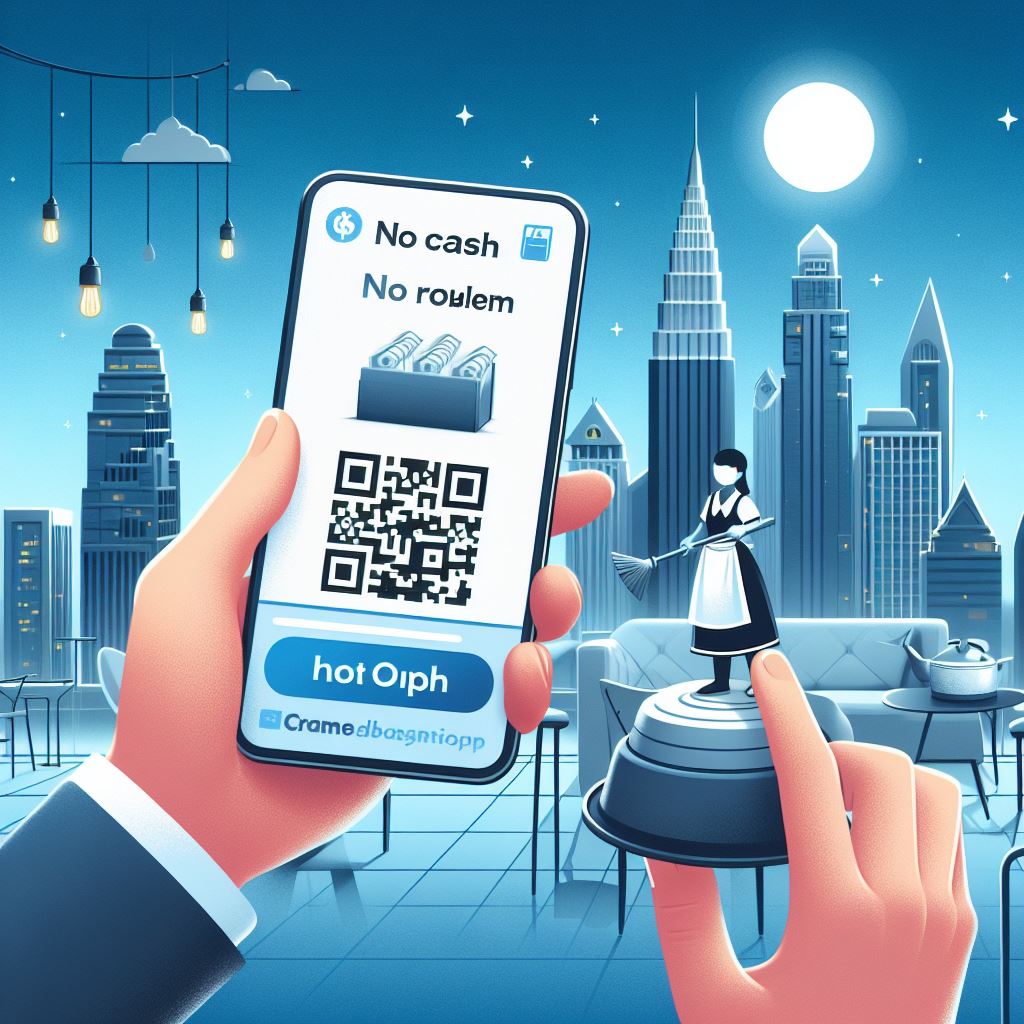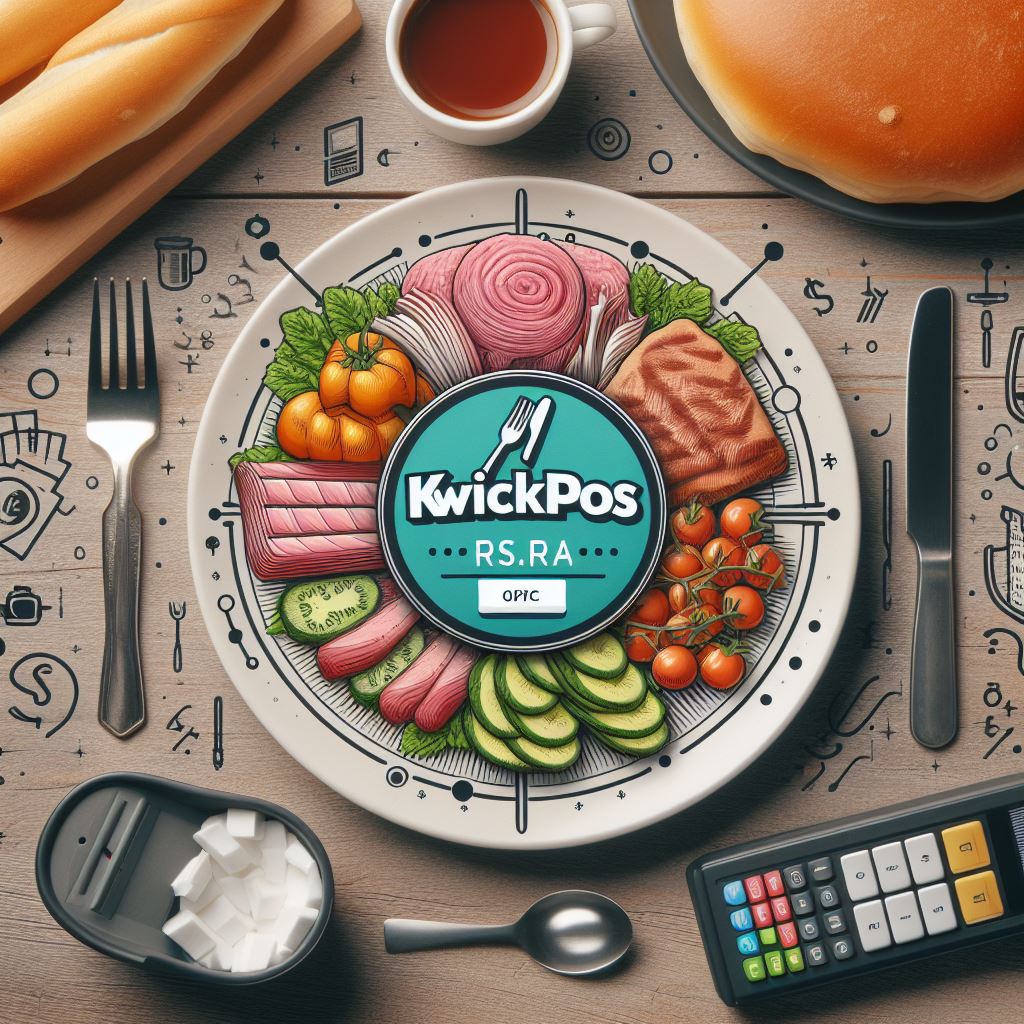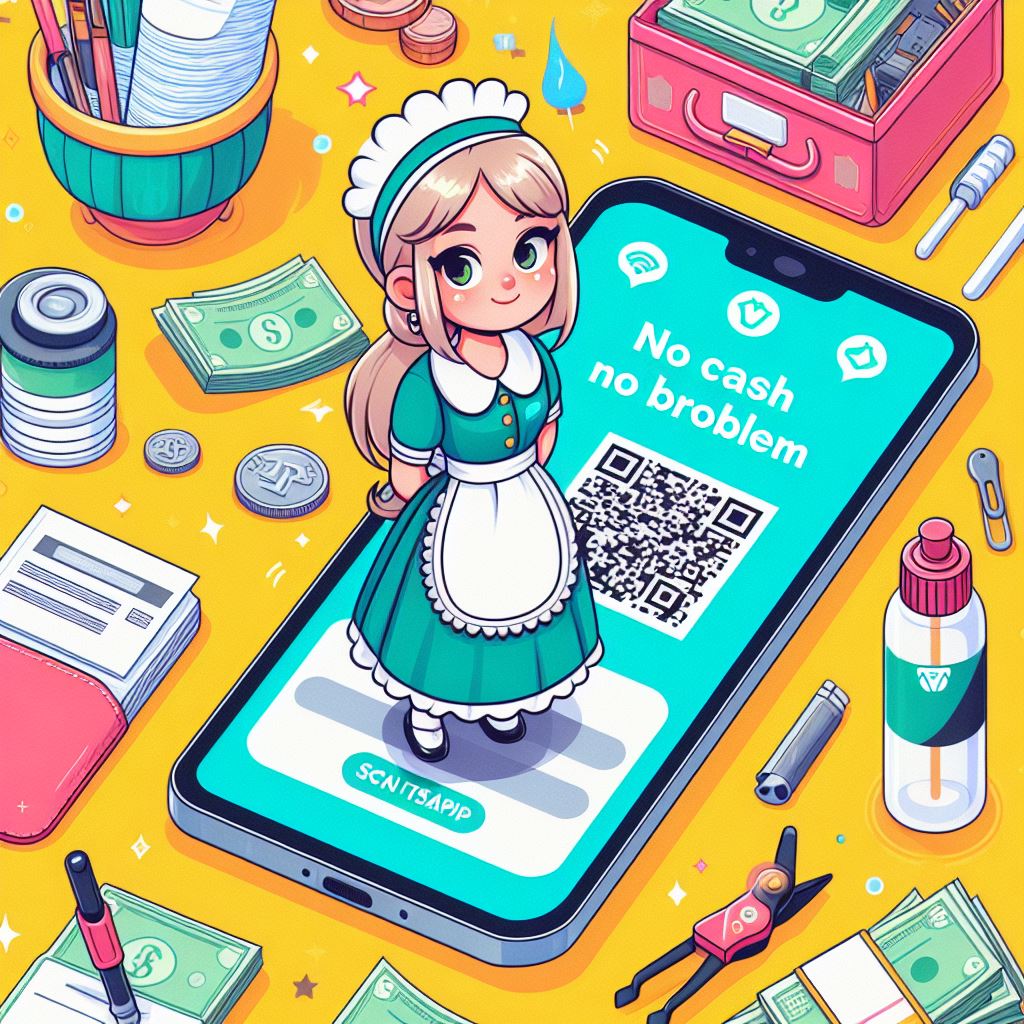For Guests:
- Locate the staff member you wish to tip.
- Look for the unique QR code associated with the staff member. This code might be displayed on their name tag, a receipt, or another designated location.
- Open your smartphone camera app and point it at the QR code.
- Your phone should automatically launch the link associated with the code. This might open a webpage or a dedicated tipping application.
- Enter your desired tip amount.
- Choose your preferred payment method. This might involve linking your credit card, debit card, or mobile wallet to the platform.
- Complete the transaction by following the on-screen prompts.
- You should receive a confirmation message once your tip is successfully processed.
For Hotels:
- Contact KwickPOS, the company behind Scantotip, to learn more about their services and pricing plans.
- If you decide to implement Scantotip, work with KwickPOS to set up the system for your hotel. This might involve creating accounts, configuring user access, and integrating the system with your existing point-of-sale or hotel management system (if applicable).
- Train your staff members on how to use Scantotip and answer guest questions about the system.
- Promote the availability of Scantotip to your guests through signage, website information, or verbal communication.
Scantotip aims to address several challenges and opportunities within the hospitality industry, specifically related to guest tipping and staff satisfaction. Here are some reasons why Scantotip might be considered valuable:
For Guests:
- Convenience: Scantotip offers a quick and easy way to tip using a familiar method - their smartphones. This eliminates the need to carry cash or search for an ATM, improving the overall guest experience.
- Security: Scantotip utilizes secure QR code technology and industry-standard payment processing to ensure safe and secure transactions. This can provide peace of mind to guests who might be hesitant to carry cash or hand over their credit cards.
- Transparency: Knowing the tip amount goes directly to the staff member they are intending to thank can be a more transparent and motivating way for guests to show their appreciation.
For Hotels:
- Improved guest satisfaction: By offering a modern and convenient tipping option, hotels can potentially enhance guest satisfaction and create a more positive overall experience. Satisfied guests are more likely to leave positive reviews and return for future stays.
- Increased staff morale and potentially higher gratuities: Providing a seamless and convenient way for guests to tip can boost staff morale and potentially lead to higher gratuity amounts. This can have a positive impact on employee satisfaction and retention.
- Streamlined operations: Eliminating cash handling associated with traditional tipping methods can simplify accounting and streamline operations for hotels. This can save time and resources for hotel staff.
Additionally:
- Cashless tipping is becoming increasingly popular: As society trends towards cashless transactions, Scantotip provides hotels with a solution to meet evolving guest preferences and expectations.
- Potential for data and insights: Utilizing a digital tipping system can potentially provide hotels with valuable data and insights into guest tipping trends and staff performance. This information can be used to improve operations and guest satisfaction further.
It's important to note that the decision to implement a cashless tipping solution like Scantotip ultimately rests with individual hotels. While it offers potential benefits in terms of convenience, security, and potential improvements in guest satisfaction and staff morale, it's crucial to consider factors such as guest demographics, local tipping customs, and potential technology adoption challenges before making a decision.
Placing a QR code correctly involves a combination of physical placement and design considerations to ensure it's easily scannable and user-friendly:
Physical Placement:
- Accessibility: Choose a location that is readily accessible to your target audience and allows them to comfortably scan the code without difficulty. Avoid placing it too high, too low, or in a crowded area.
- Visibility: Ensure the code is readily visible against its background. Choose an area with good lighting and avoid placing it on reflective surfaces or glossy materials that can hinder scanning.
- Space: Provide enough clear space around the code for users to comfortably position their smartphone camera for scanning. Don't overcrowd the code with other information that might obstruct the view.
- Durability: If the code will be displayed outdoors or in a high-traffic area, consider using a material that is weatherproof and resistant to wear and tear. Laminating the code can be a simple solution.
Design Considerations:
- Size: Make sure the QR code is large enough to be scanned easily from a reasonable distance. The minimum recommended size is usually 2 x 2 cm or 0.8 x 0.8 inches, but this can vary depending on the medium it's displayed on and the intended scanning distance.
- Contrast: Use a high-contrast color scheme between the QR code's foreground (black squares) and the background. Avoid light colors for the background and ensure the code has clear, distinct squares.
- Error correction: Implement error correction when generating the QR code. This adds redundancy to the code, allowing it to be read even if partially damaged or obscured.
- Call to action: Include a clear and concise call to action (CTA) near the QR code that tells users what they should do after scanning (e.g., "Scan to Tip," "Visit Our Website").
Additional Tips:
- Test the QR code: Before deploying the code, use a QR code reader app on your smartphone to test its functionality under different lighting conditions and from various angles.
- Consider a frame or border: A simple border around the code can help users locate it quickly and improve scannability.
- Mobile-friendly landing page: Ensure the webpage linked to the QR code is optimized for mobile devices to provide a seamless user experience for those scanning the code.
By following these tips and considering both physical placement and design, you can effectively position your QR code for optimal scannability and user engagement. Remember, the goal is to make the process as smooth and intuitive as possible for your target audience.
Here are some best practices for using QR codes effectively:
1. Size and clarity:
- Ensure the QR code is large enough to be scanned easily, especially from a reasonable distance. The minimum recommended size is usually 2 x 2 cm or 0.8 x 0.8 inches, but this can vary depending on the size of the medium it's displayed on and the intended scanning distance.
- Make sure the code is printed or displayed on a clear and contrasting background with good lighting to ensure optimal scannability.
2. Error correction:
- Implement error correction when generating the QR code. This adds redundancy to the code, allowing it to be read even if partially damaged or obscured.
3. Call to action:
- Include a clear and concise call to action (CTA) near the QR code that tells users what they should do after scanning (e.g., "Scan to Tip," "Visit Our Website").
4. Landing page optimization:
- Ensure the webpage linked to the QR code is mobile-friendly and optimized for smartphones. This guarantees a smooth user experience for those scanning the code.
5. Test and track:
- Test the QR code with different devices and lighting conditions to ensure it scans correctly. Consider using online tools or QR code reader apps to test its functionality.
- If possible, track the number of scans and engagement on the landing page to understand the effectiveness of your QR code campaign.
Additional tips:
- Avoid placing QR codes on complex backgrounds or glossy surfaces.
- Incorporate a logo or branding element within the QR code for better recognition and brand association.
- Consider adding a dynamic QR code that can be updated to different URLs if needed.
- Promote your QR code campaign across different channels to increase awareness and engagement.
By following these best practices, you can create effective and user-friendly QR codes that successfully achieve your desired goals, whether it's directing users to a website, facilitating cashless transactions, or providing additional information.
A QR code (Quick Response code) for tips is a two-dimensional barcode that, when scanned by a smartphone camera, takes the user to a digital payment platform where they can leave a tip for the person or entity displaying the code.
Here's how it works:
- Generate a QR code: Individuals or businesses can generate a unique QR code using various online services or smartphone applications. This code can be customized to include branding information or specific instructions.
- Display the QR code: The generated code can be displayed physically on posters, business cards, receipts, or any surface accessible for scanning.
- Scanning and payment: Users scan the code with their smartphone camera, which launches the embedded link. This link typically leads to a secure online payment platform like Venmo, Cash App, PayPal, or a dedicated tipping service.
- Leaving a tip: The user enters their desired tip amount and chooses their preferred payment method within the opened platform and completes the transaction.
Benefits of using a QR code for tips:
- Convenience: Both for the person receiving the tip (no need to handle cash) and the one leaving the tip (quick and easy process using their smartphone).
- Cashless transactions: Eliminates the need to carry cash or handle physical money, potentially improving hygiene and reducing concerns about handling cash.
- Increased accessibility: Enables anyone with a smartphone to leave a tip, regardless of their preferred payment method.
- Improved tracking: For businesses, using QR codes can facilitate easier tracking and management of received tips.
Examples of who can use QR codes for tips:
- Restaurants and cafes: Allow customers to leave tips for servers and bartenders.
- Street performers and musicians: Provide a way for audiences to show their appreciation.
- Retail stores and service providers: Enable customers to leave gratuities for delivery personnel or service staff.
- Content creators and artists: Offer fans a way to show support and potentially receive additional income.
Overall, QR codes for tips offer a convenient, cashless, and accessible way for individuals and businesses to receive gratuities in today's digital world.
A wide range of individuals and entities can benefit from using a virtual tip jar, offering a way to receive financial support from their audience or community. Here are some examples:
Creators and Artists:
- YouTubers, Streamers, and Podcasters: These online content creators often use virtual tip jars to supplement their income generated through advertising or other channels.
- Musicians and Performers: Virtual tip jars can be a good fit for musicians who offer live online performances or share exclusive content, allowing fans to show their appreciation.
- Writers, Bloggers, and Visual Artists: These creative individuals can use virtual tip jars to collect donations or gain financial support from their readers or viewers, potentially enabling them to continue creating content.
Individuals Providing Services:
- Freelancers and Independent Contractors: Virtual tip jars allow these individuals to receive additional financial appreciation from satisfied clients beyond the agreed-upon project fee.
- Consultants and Educators: They can utilize virtual tip jars to receive additional support from clients or students who find their services valuable.
Others:
- Non-profit organizations: Virtual tip jars can be a good option for raising additional funds for their cause, allowing supporters to easily contribute small amounts.
- Personal causes: Individuals raising funds for personal needs, like medical expenses or educational pursuits, can use virtual tip jars as a way to receive financial support from their network.
Factors to Consider:
While anyone can utilize a virtual tip jar, it's important to ensure:
- Clear value proposition: Clearly communicate to potential contributors the value they receive in exchange for their support, whether it's access to exclusive content, continued creation of free content, or simply supporting your work or cause.
- Transparency: Be transparent about how the collected funds will be used, especially if you're raising money for a personal cause.
- Compliance: Depending on your location and circumstances, there may be legal or tax implications associated with receiving online payments. It's advisable to research and comply with any relevant regulations.
Overall, using a virtual tip jar can be a valuable tool for anyone looking to receive financial support from their audience or community. However, it's crucial to prioritize transparency, value-exchange, and compliance with local regulations for ethical and successful implementation.
- VMbook Your Ultimate Food Adventure
- Revolutionize Guest Tipping and Empower Your Staff with Scantotip
- why do we need ScantoTIP
- what is qr code for tips
- how to tip service workers
- Scantip com is a game changing platform that allows you to tip hotel workers cashlessly
- Why did the Bitcoin miner go to Disneyland
- Good rule of thumb is to tip 2 to 5 per night of your stay
- Tipping culture in the USA
- a comparison of tipping etiquette in New York City and Miami
- some tips on how to place your tipping QR code in the right position
- Meeting hoteliers
- The Gentle Touch of Spring A Reminder of Kindness
- Keep tipping history in one place
- These testimonials resonate like sweet melodies
- Branding opportunities
- Scantotip services enhance operational efficiency for hotel management
- QR code based tipping solution for contactless guest experiences
- ScantoTIP Elevating Tipping Experiences in Las Vegas
- Simplifying Tipping with Convenience
- Whispers of Gratitude
- Digital Tipping
- Complete Guide How to earn more tips as a concierge
- Tipping Hotel Housekeeping A Grateful Gesture
- Tipping Airbnb hosts
- compare ScantoTIP with other digital tipping platforms
- Reasons to pick ScantoTIP over others
- How to place a QR code correctly
- Who can use a virtual tip jar
- A tale of cashless tip
- housekeeping gratuity for hotel maids in New York
- Visiting New York hotel gratuities
- the art of tipping housekeepers in the Empire State
- Tipping culture in the United States
- Tipping in San Francisco
- hospitality events happening in the United States in 2024
- Hospitality conferences and tradeshows
- Embracing the Spirit of Spring Recognizing the Hard Work of Hotel Maids
- The Convenient and Transparent Way to Tip Hotel Staff
- ScantoTIP User Testimonials
- Scaling Whispers to Roars
- Convenience for guests
- Revolutionizing Tipping in the Hospitality Industry
- ScantoTIP Elevating Tipping Experiences in Los Angeles
- Elevating Tipping Experiences
- Design your QR Code right
- What Is Cashless Tipping
- Tipping etiquette for motels
- A poem about ScantoTIP
- When to Tip Your Valet
- Tired of Confusing Comparisons Choose Scantotip for Effortless Tipping
- How can I utitlize ScantoTIP
- best practices for qr codes
- What is a virtual tip jar
- TIP To Insure Promptness
- tipping your hotel maid in New York
- let s talk about tipping house cleaners in New York City hotels
- tipping at hotels in New York
- Tipping London vs New York
- Placing your tipping QR code in a strategic location within your hotel can indeed maximize its visibility and scanning potential
- hospitality events in 2024
- The Gentle Touch of Spring A Symphony of Renewal and Human Kindness
- Tracking tipping history is optional
- ScantoTIP User Experience Expanding on the Highlights
- A harmonious blend of efficiency guest satisfaction and brand elevation
- Improved staff morale by utilizing ScantoTIP
- Easy to use cashless tipping system for independent hotel owners
- A cutting edge cashless tipping solution
- Elevating Tipping Experiences in New York
- 2024 Cashless Tipping Powered by ScantoTIP
- Transforming Tipping in the Hospitality Industry
- How much to tip valet drivers in 2024
- Tip your guider
- A Cashless Tipping Marvel
- Why Is Tipping So Important in the USA
- VMbook Your Ultimate Food Adventure
- compare ScantoTIP with other digital tipping platforms
- Tired of Confusing Comparisons Choose Scantotip for Effortless Tipping
- Revolutionize Guest Tipping and Empower Your Staff with Scantotip
- Reasons to pick ScantoTIP over others
- How can I utitlize ScantoTIP
- why do we need ScantoTIP
- How to place a QR code correctly
- best practices for qr codes
- what is qr code for tips
- Who can use a virtual tip jar
- What is a virtual tip jar
- how to tip service workers
- A tale of cashless tip
- TIP To Insure Promptness
- Scantip com is a game changing platform that allows you to tip hotel workers cashlessly
- housekeeping gratuity for hotel maids in New York
- tipping your hotel maid in New York
- Why did the Bitcoin miner go to Disneyland
- Visiting New York hotel gratuities
- let s talk about tipping house cleaners in New York City hotels
- Good rule of thumb is to tip 2 to 5 per night of your stay
- the art of tipping housekeepers in the Empire State
- tipping at hotels in New York
- Tipping culture in the USA
- Tipping culture in the United States
- Tipping London vs New York
- a comparison of tipping etiquette in New York City and Miami
- Tipping in San Francisco
- Placing your tipping QR code in a strategic location within your hotel can indeed maximize its visibility and scanning potential
- some tips on how to place your tipping QR code in the right position
- hospitality events happening in the United States in 2024
- hospitality events in 2024
- Meeting hoteliers
- Hospitality conferences and tradeshows
- The Gentle Touch of Spring A Symphony of Renewal and Human Kindness
- The Gentle Touch of Spring A Reminder of Kindness
- Embracing the Spirit of Spring Recognizing the Hard Work of Hotel Maids
- Tracking tipping history is optional
- Keep tipping history in one place
- The Convenient and Transparent Way to Tip Hotel Staff
- ScantoTIP User Experience Expanding on the Highlights
- These testimonials resonate like sweet melodies
- ScantoTIP User Testimonials
- A harmonious blend of efficiency guest satisfaction and brand elevation
- Branding opportunities
- Scaling Whispers to Roars
- Improved staff morale by utilizing ScantoTIP
- Scantotip services enhance operational efficiency for hotel management
- Convenience for guests
- Easy to use cashless tipping system for independent hotel owners
- QR code based tipping solution for contactless guest experiences
- Revolutionizing Tipping in the Hospitality Industry
- A cutting edge cashless tipping solution
- ScantoTIP Elevating Tipping Experiences in Las Vegas
- ScantoTIP Elevating Tipping Experiences in Los Angeles
- Elevating Tipping Experiences in New York
- Simplifying Tipping with Convenience
- Elevating Tipping Experiences
- 2024 Cashless Tipping Powered by ScantoTIP
- Whispers of Gratitude
- Design your QR Code right
- Transforming Tipping in the Hospitality Industry
- Digital Tipping
- What Is Cashless Tipping
- How much to tip valet drivers in 2024
- Complete Guide How to earn more tips as a concierge
- Tipping etiquette for motels
- Tip your guider
- Tipping Hotel Housekeeping A Grateful Gesture
- A poem about ScantoTIP
- A Cashless Tipping Marvel
- Tipping Airbnb hosts
- When to Tip Your Valet
- Why Is Tipping So Important in the USA





